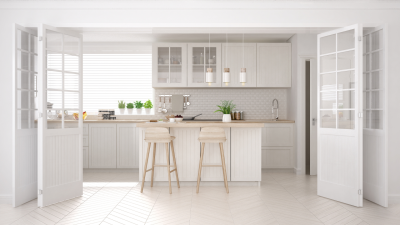We’ve all come across those popular TV shows where an old, crumbling home is turned into a modern masterpiece. Either a professional real estate agent, or an ordinary individual, comes across a home that has fallen into deep disrepair and helps it to rise from the ashes, so to speak. In today’s housing market, flipped homes like these are becoming increasingly more popular. So where did home flipping start? And how has it affected the real estate market?
 What’s a Flip?
What’s a Flip?
A home is considered ‘flipped’ when “a real estate investor buys a house with the intention to increase the value through updates and repairs before selling the home for a higher price.” [1] The practice of flipping homes began in the United States in the 1980’s. The country was facing an economic recession and many homes were going under foreclosure. Investors would purchase these foreclosed homes, repair them, and resell them for a higher price as the housing market began to recover. [2] Since then, house flipping has continued to grow in popularity.
There was a brief drop in the number of flipped homes after the housing market crash in 2008, but it didn’t last. [3] In 2022, these numbers reached an all time high as house flipping has become a popular career choice for many. So how have flipped homes affected the real estate market?
 The Pros
The Pros
Aside from the money made by the investor, house flipping has many benefits for both the buyer and surrounding community as well. Older homes that are in need of major repairs can finally get the attention they need and once again become a welcoming place to live. Many of these homes are also updated to fit modern styles during the flipping process, which helps increase its value in the long run.
Home flipping can also help to refurbish a run-down community, benefitting all who live there. “An influx of flippers can help rehabilitate a region where the homes have fallen into disrepair by providing much-needed facelifts. This can help raise property values and increase equity for those who already live there” [4]. Not only do the flipped homes themselves increase in value, but also homes in the surrounding area.
The Cons
While this increase in prices may benefit those already living in the area, it can also have a negative impact on those trying to buy a new home. Researcher Ada Focer explains, “as the price of flipped homes goes up, other sellers raise their prices, which can result in a low-income neighborhood with affordable housing becoming much more expensive” [5]. When a cheaper home is purchased to be flipped, it is then sold at a higher price which also drives up prices of similar and nearby homes.
Having a high quantity of flipped homes can also raise the prices for renters. One study states, “rental units in small homes that have been flipped are often subject to sharp increases in rent as new investor owners look to maximize profits. Renovations and added bedrooms command rents far above those claimed by the previous owners, often working class owner‐occupant families” [6]. These price increases can have a huge impact on affordable housing for both renters and buyers.
 The Takeaway
The Takeaway
House flipping is an increasingly popular practice that has seemed to take over our television channels, as well as the real estate market. It has had an equally widespread effect on the housing market by increasing the value of older, run-down homes. From giving worn-out homes some much needed TLC, to increasing the street value of neighboring houses, flipped homes can have many positive effects on a community. When these flipped homes become too concentrated however, the price increases that follow can also damage a market by limiting the accessibility of affordable housing. Despite the potential negative effects, house flipping in moderation has proven to revitalize dying communities and help support home values and continued market growth.
Sources
[3]https://www.attomdata.com/news/market-trends/flipping/attom-q1-2022-u-s-home-flipping-report/
[4]https://www.loandepot.com/knowledge-cafe/home-refinance/flipping-is-back-how-it-affects-market
[5]https://homeguides.sfgate.com/essential-gardening-tools-13771632.html
[6]https://cnycn.org/wp-content/uploads/2016/04/CNYCN-NYC-Flipping-Analysis.pdf
